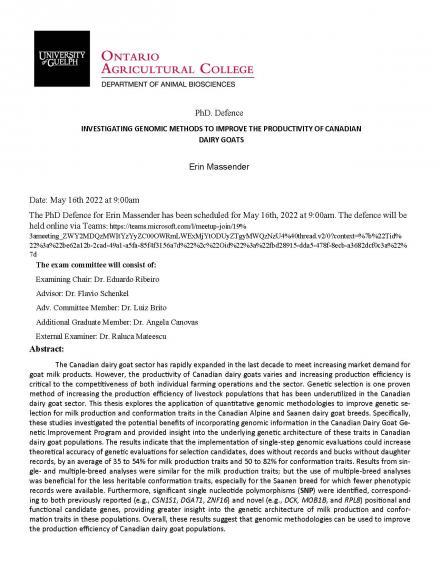Erin Massender's PhD Defence
Date and Time
Location
Teams: https://teams.microsoft.com/l/meetup-join/19%3ameeting_ZWY2MDQzMWItYzYyZC00OWRmLWExMjYtODUyZTgyMWQzNzU4%40thread.v2/0?context=%7b%22Tid%22%3a%22be62a12b-2cad-49a1-a5fa-85f4f3156a7d%22%2c%22Oid%22%3a%22fbd28915-dda5-478f-8ecb-a3682dcf0c3a%22%7d

Details
The Canadian dairy goat sector has rapidly expanded in the last decade to meet increasing market demand for goat milk products. However, the productivity of Canadian dairy goats varies and increasing production efficiency is critical to the competitiveness of both individual farming operations and the sector. Genetic selection is one proven method of increasing the production efficiency of livestock populations that has been underutilized in the Canadian dairy goat sector. This thesis explores the application of quantitative genomic methodologies to improve genetic se-lection for milk production and conformation traits in the Canadian Alpine and Saanen dairy goat breeds. Specifically, these studies investigated the potential benefits of incorporating genomic information in the Canadian Dairy Goat Ge-netic Improvement Program and provided insight into the underlying genetic architecture of these traits in Canadian dairy goat populations. The results indicate that the implementation of single-step genomic evaluations could increase theoretical accuracy of genetic evaluations for selection candidates, does without records and bucks without daughter records, by an average of 35 to 54% for milk production traits and 50 to 82% for conformation traits. Results from sin-gle- and multiple-breed analyses were similar for the milk production traits; but the use of multiple-breed analyses was beneficial for the less heritable conformation traits, especially for the Saanen breed for which fewer phenotypic records were available. Furthermore, significant single nucleotide polymorphisms (SNP) were identified, correspond-ing to both previously reported (e.g., CSN1S1, DGAT1, ZNF16) and novel (e.g., DCK, MOB1B, and RPL8) positional and functional candidate genes, providing greater insight into the genetic architecture of milk production and confor-mation traits in these populations. Overall, these results suggest that genomic methodologies can be used to improve the production efficiency of Canadian dairy goat populations.